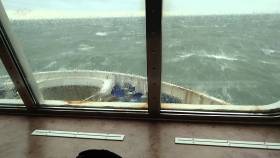Displaying items by tag: Delayed Sailings
Storm Doris Sweeps Across Irish Sea Leading to Ferry Travel Disruption
#StormDoris – Travel disruption due to Storm Doris has led to one of the largest ferries on the Irish Sea unable to enter Dublin Port due to the adverse weather conditions.
An attempt however by the 44,000 gross tonnage Stena Adventurer is now estimated to take place around 12.30 this afternoon. Other routes and ferry operators have also been affected with either cancelled sailings and delays arising from the fourth storm of this winter.
Stena Adventurer was scheduled to arrive in Dublin Port at 05.45hrs however high seas have led to a delay of six hours so far. The ferry which can accommodate 1,500 passengers had been circling Dublin Bay but later moved off Bray Head to wait for weather conditions to abate.
The corresponding return sailing of Stena Adventurer from Dublin of 08.20hrs this morning has been changed to 14.00hrs.
A fleetmate on the Ireland-Wales route, Stena Nordica had cancelled overnight sailings but is scheduled to take up the routine 15.10 sailing this afternoon to Holyhead.
Stena Nordica which used to serve the route had only entered service in recent days to cover the refit dry-docking of Stena Superfast X which is at Harland & Wolff, Belfast.
For the latest information on Stena Line sailing updates and from other routes click here
For Irish Ferries click this link. Noting certain Jonathan Swift fast-craft sailings and those by ropax Epsilon have been cancelled, though the larger flagship Ulysses remains operating as scheduled.
Those intending to travel on P&O’s North Channel route between Larne-Cairnryan click here. For the Dublin-Liverpool route click here.
Met Eireann earlier this morning issued a Marine Weather Warning of Status Orange. The Warning is for gale to storm force west or northwest winds continuing this morning on all coasts of Ireland and on the Irish Sea. For further weather updates click here





























































